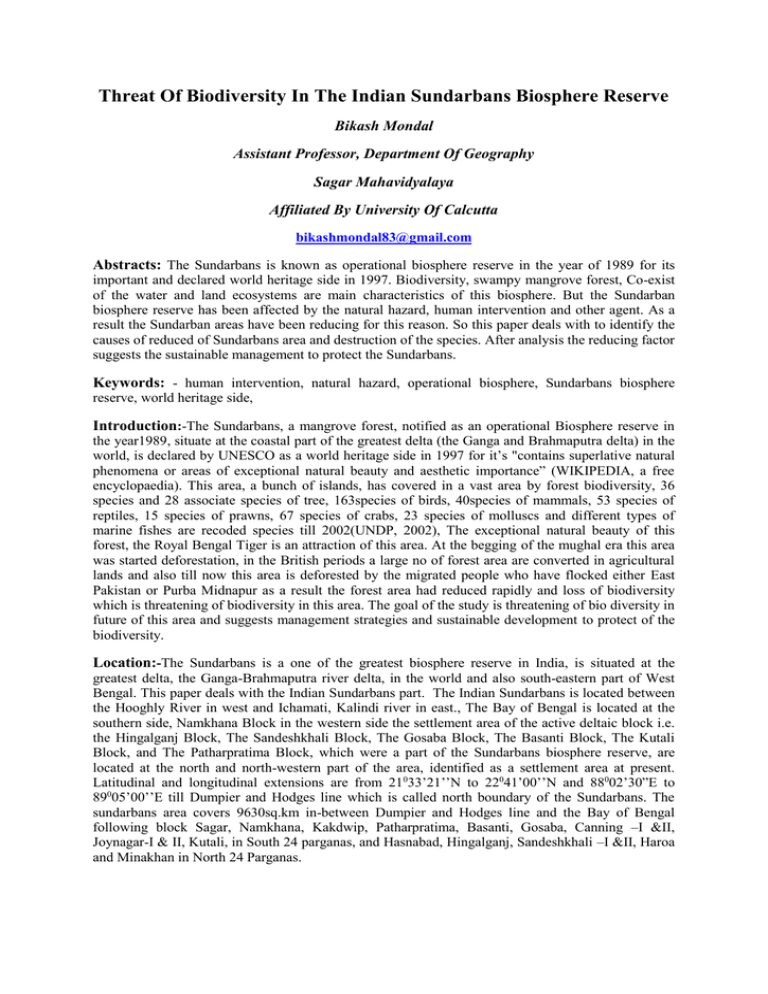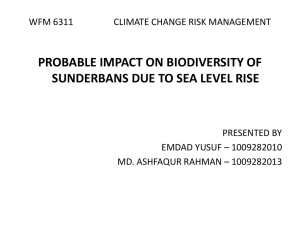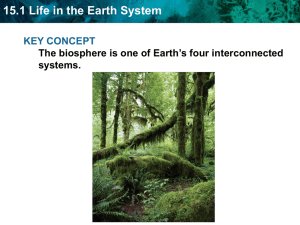threat - International Journal of Computing and Corporate
advertisement

Threat Of Biodiversity In The Indian Sundarbans Biosphere Reserve Bikash Mondal Assistant Professor, Department Of Geography Sagar Mahavidyalaya Affiliated By University Of Calcutta bikashmondal83@gmail.com Abstracts: The Sundarbans is known as operational biosphere reserve in the year of 1989 for its important and declared world heritage side in 1997. Biodiversity, swampy mangrove forest, Co-exist of the water and land ecosystems are main characteristics of this biosphere. But the Sundarban biosphere reserve has been affected by the natural hazard, human intervention and other agent. As a result the Sundarban areas have been reducing for this reason. So this paper deals with to identify the causes of reduced of Sundarbans area and destruction of the species. After analysis the reducing factor suggests the sustainable management to protect the Sundarbans. Keywords: - human intervention, natural hazard, operational biosphere, Sundarbans biosphere reserve, world heritage side, Introduction:-The Sundarbans, a mangrove forest, notified as an operational Biosphere reserve in the year1989, situate at the coastal part of the greatest delta (the Ganga and Brahmaputra delta) in the world, is declared by UNESCO as a world heritage side in 1997 for it’s "contains superlative natural phenomena or areas of exceptional natural beauty and aesthetic importance” (WIKIPEDIA, a free encyclopaedia). This area, a bunch of islands, has covered in a vast area by forest biodiversity, 36 species and 28 associate species of tree, 163species of birds, 40species of mammals, 53 species of reptiles, 15 species of prawns, 67 species of crabs, 23 species of molluscs and different types of marine fishes are recoded species till 2002(UNDP, 2002), The exceptional natural beauty of this forest, the Royal Bengal Tiger is an attraction of this area. At the begging of the mughal era this area was started deforestation, in the British periods a large no of forest area are converted in agricultural lands and also till now this area is deforested by the migrated people who have flocked either East Pakistan or Purba Midnapur as a result the forest area had reduced rapidly and loss of biodiversity which is threatening of biodiversity in this area. The goal of the study is threatening of bio diversity in future of this area and suggests management strategies and sustainable development to protect of the biodiversity. Location:-The Sundarbans is a one of the greatest biosphere reserve in India, is situated at the greatest delta, the Ganga-Brahmaputra river delta, in the world and also south-eastern part of West Bengal. This paper deals with the Indian Sundarbans part. The Indian Sundarbans is located between the Hooghly River in west and Ichamati, Kalindi river in east., The Bay of Bengal is located at the southern side, Namkhana Block in the western side the settlement area of the active deltaic block i.e. the Hingalganj Block, The Sandeshkhali Block, The Gosaba Block, The Basanti Block, The Kutali Block, and The Patharpratima Block, which were a part of the Sundarbans biosphere reserve, are located at the north and north-western part of the area, identified as a settlement area at present. Latitudinal and longitudinal extensions are from 21033’21’’N to 22041’00’’N and 88002’30”E to 89005’00’’E till Dumpier and Hodges line which is called north boundary of the Sundarbans. The sundarbans area covers 9630sq.km in-between Dumpier and Hodges line and the Bay of Bengal following block Sagar, Namkhana, Kakdwip, Patharpratima, Basanti, Gosaba, Canning –I &II, Joynagar-I & II, Kutali, in South 24 parganas, and Hasnabad, Hingalganj, Sandeshkhali –I &II, Haroa and Minakhan in North 24 Parganas. LOCATION OF THE SUNDARBAN BIOSPHERE RESERVE Designed by- Bikash Mondal Methodology:-Different standard methodologies have used to collect data in different fields in sundarbans area. At first visit the different island which is situated the periphery of the sundarbans biosphere reserve to collect data and then the different journals and book are used for supporting documents. After analysis the data software is used to prepare maps, diagrams and this paper suggests saving sundarbans and sustainable use of resources and management of this area. Aims and Objectives of the Study:-The Sundarbans biosphere reserve, world famous biosphere for its unique beauty, is found of co-existed of the land and water ecosystem. But the increasing the population this mangrove forest area are converted into agricultural area also settlements area. Everyday this biosphere reserve is reducing by the different agent i.e. natural and Cultural. So this paper deals with causes of reducing of the Sundarbans biosphere reserve and protect the sundarbans biosphere reserve with proper guideline. The main Objectives are:i) ii) iii) iv) To identify the reducing agents of Sundarban. Demarked the Sundarbans area and trend of reduced this area. To identify effect of reducing biosphere reserve in The Sundarbans. Suggests how to reclaimed the forest area and protect existing forest area. Characteristics of This Area: Physiography:-Physically this area is built up on the active deltaic area of the distributaries of the river Ganga and the river Brahmaputra. These deltas of the Sundarbans have stabilized in between 5th to 7th century AD. This delta is known as the world largest delta which is covering near about 65000sq.k. (A Brief History of The Sundarbans By Sumit Sen, 2007) More over in the polite literature ‘Mansa Mangal’ Candsadagar, hero of Manasa Mangal, have found a forest name as a baghmara forest. This literature is based on the story of Hindus goddess ‘Manasa’ who is goddess of the Hindu and the symbol of snake, which was more found in the swampy and dense forest area. So it is remarkable that this area was a dense forest area. The islands of the Sundarbans are made with transported soil, sediments and sands, are situated above the more or less 5 to 10 metre height from the sea level and total islands are isolated by the different types of tidal Rivers and Water Creeks. In the biosphere reserve have no boundary around the edge of island as a result the river inundate the inward in the swampy area with transported soil and other materials is deposited when the water level is stable. River: - At the time of forming islands the rivers of the Sundarbans have created between two islands. These rivers are Gosaba, Bidhyadhari, Raimangal, Dansha, Durgaduania, Muriganga, and Hatania doania, Matla, Kalindi, Saptamukhi, Gomar and Jamira etc. Based on these rivers different types of ecosystem are built up here. Different type of fish, arthropoda, molluscs, reptiles and other water creature are inhabitant in this area that is formed as river or marine eco-system. Most of the river is lost their course for the deposited of the transported soil, sands and others materials. Climate: - Tropical Monsoon climate dominate in the islands and adjoining area of this Sundarbans. The climate is affected by the Bay of Bengal in the southern part of this biosphere. In the influence of the south-western monsoon wind which is blowing above the sea, is raining in the summer monsoon. Most of rainfall is recorded here in the month of mid June to Mid September. The annually rainfall is recorded 1358.10m.m, annually maximum temperature is recorded in the month of May 380C and minimum temperature is recorded at the month of January 120. Sometimes cyclone which create in the sea, affect on this area .In the month of the May to June this islands of sundarbans have affected by a cyclone local name as the ‘Kalbaiskhi’ and the end of the rainy season this area is also affected by the storm or cyclone name as ‘Aswiner Jhar’. Moreover this area is also affected by the western disturbance which enters at the edge of the western part of India and is extended to the West Bengal and influence the weather in these islands. Soil: - This area is made by the transported soil, which composites with sediment, clay, sands and organic matter. This soil is too saline for the effect of tidal Saline River and this area is reclaimed from the sea level. The mud flow is a one of the characteristics of the soil in the biosphere reserve. This soil is too saline that is appropriate to growth of the mangrove forest, which is called swampy forest. Heavy texture is the one of the mentionable character of this soil. This mudflow of soil in the swampy forest is the living place of the different type of fish and crab and also mangrove tree. Flora: - This area covers with the mangrove forest which is called swampy forest. Pneumatophore is the main characteristics of the tree in this area. Different types of tree or species, 36 species and 28 associate species of tree also mention above are found in the biosphere reserve like sundari (Heritiera fomes), gewa (Excoecaria agallocha), dhundul or passur (Xylocarpus granatum) and kankra (Bruguiera gymnorrhiza) palms, Poresia coaractata, Myriostachya wightiana and golpata (Nypa fruticans), and among grasses spear grass (Imperata cylindrica) and khagra (Phragmites karka) goran (Ceriops decandra) keora (Sonneratia apetala jat bain, payara bain, kalo bain,(local name) etc. Mangrove Tree in the Sundarbans; Picture Capture by Author Fauna:- There are numerous fauna belongs in the forest ecosystem and river or marine ecosystem like Royal Bengal tiger (Panthera tigris), jungle cats (Felis chaus), fishing cats (Prionailurus viverrinus), and leopard cats (Prionailurus bengalensis) chital deer (axis axis) saltwater crocodile (Crocodylus porosus) and mugger crocodile (Crocodylus palustris), as well as the gharial (Gavialis gangeticus) and the water monitor lizards (Varanus salvator) brown-winged kingfishers (Pelargopsis amauroptera) lesser adjutants (Leptoptilos javanicus) and masked finfoots (Heliopais personata) and birds of prey such as the ospreys (Pandion haliaetus), white-bellied sea eagles (Haliaeetus leucogaster) and grey-headed fish eagles (Ichthyophaga ichthyaetus),largetooth sawfish (Pristis microdon) mudskipper (Periophthalmus argentilineatus)sawfish, butter fish, electric ray, common carp, silver carp, barb, river eels, starfish, king crab, fiddler crab, hermit crab, prawn, shrimps, Gangetic dolphins, skipping frogs, common toads and tree frogs,mudskipper, a gobioid that climbs olive ridley turtles, sea snakes, dog faced water snakes, green turtles, estuarine crocodiles, chameleons, king cobras, salvator lizards, hard shelled batgun terrapins, Russels vipers, mouse gekkos, monitor lizards, curviers, hawks bill turtles, pythons, common kraits, green vine snake, checkered keelbacks and rat snakes. The river terrapin (Batagur baska), Indian flap-shelled turtles (Lissemys punctata), peacock soft-shelled turtles (Trionyx hurum), yellow monitors (Varanus flavescens), water monitors (Varanus salvator), and Indian pythons (Python molurus) and different types of unknown fauna are found here. Fauna:-Picture Capture By author in Sundarbans Biosphere History of Reducing of the Sundarbans Area At the beginning of the British rules in India this sundarban area was extended from coast the Bay of Bengal to the Kolkata where the East India Company was started their British India. In this period this sundarbans area covered about 19200k.m.In British India this sundarbans have converted in agriculture region and the mughal era this area known as parganas which is the sources of revenue of the Mughal and British India. In the year of 1876 these areas have converted to the agricultural land and total sundarban area was reduced 14100k.m and later on a large no of mangrove have destructed by the flocked people from Bangladesh and the western part of the Hooghly. Now the Sundarban biosphere reserve covers 4265 sq.k.m. If this destruction process is continued the Sundarban biosphere reserve has possibilities to abolish from the Map of India. Causes of Threat of Bio Diversity in Sundarbans:i) The Sundarbans As A Revenue Area: - This area was building up in between 4th to 7th century but this islands was started to transfer into a mangrove forest after 7th century onward but in the century of 10th to 12th (In the ear of Sultan in Bengal) and onward this islands of the sundarbans was transferred into a dense mangrove forest. And mughal periods (1526 onward) this area has been transferring into a more dense forest area. When the Kolkata was established (1690) by job Carnac, this area was an extended part of Sundarban only three villages, Kolkata, sultanate and Gobindapur are a remote village aspect of Murshidabad. This area has dominated by the Royal Bengal Tiger. It is mentionable that the founder of the Calcutta, Job Carnac was snubbed by the Royal Bengal Tiger in three times. It is prove that this area was a dense forest area extended parts of the Sundarbans forest. Sealdah, the busy railway station in India, was an island which was a living place of fox name ‘sial’ in Bengali term, derive from ‘Sial’ Though the sundarbans area was a shelter area of the criminal and in the revolution periods this area was also a shelter place of the freedom fighter in West Bengal for its denseness to enter. But In the period of Sultan in West Bengal this area was started to deforest and at the end of the sultaini ear and the begging of the mughal and mughal period this area is started to convert into agricultural land to earn revenue. This area is the hunting places of the king and landlords to hunt the wild animal. During the British India this area was known as revenue area and a hunting, adventurous place, At last stage of the British rule they gave different name and no in the settlement area of the Sundarbans like Hemilton abad (1904), Fregerganj, lot-8, k- plot, J-plots etc. This area was cover 7905.88sq.km in the year of 1934 and in the year of 1954. These biosphere reserve areas are reduced 4667.72sq.km till 1954 and total area was 3238.6029sq.km at that time. At last this biosphere is cover 2979.89 sq.km till 2014. Total 4926 sq.km forest areas are transferred into settlement area and agricultural till 2014. REDUCING TREND OF THE SUNDARBAN BIOSPHERE RESERVE Designed by Bikash Mondal, Assistant Professor,Sagar Mahavidyalaya ii) Human Habitat: - The Sundarbans area was extended till dumpier and Hodges line in northern parts of this area in year of 1934. Based on the vested land on this area a large no of people have flocked here to build up settlement example at the begging of the 21st century there are large area of mangrove forest are converted into agricultural land in Jharkhali known as ‘Kata Jungle’ In the time of independence and onward of India a large numbers of the settlers have flocked from Bangladesh in the eastern part of the Sundarbans in the Blocks of Hingalganj, Sandeshkhali, Minakhan, Gosaba, Basanti, and Migrated from the western parts of the Hooghly River, coastal belt of the Midnapur and adjacent area of Orissa. As a result the total areas of sundarban biosphere reserve have reduced and reducing to the increasing of population. The Sundarban which was begging to reduce at the last of mughal ere is now running. iii) Climatic Change:-Climatic change is the most threat of the Sundarbans biosphere reserve .Increasing the temperature different type of species are abolish and transformed into endangered species. Mean temperature have increased 10 to1.50 C in last fifty year as a result biodiversity of the Sundarbans enlisted in endangered biosphere reserve. Vulgarism and delay the monsoon is the reducing factor of this biosphere. Due to climatic change the animals in Sundarbans biosphere reserve has affected by the different types of diseases. The Some species are enlisted in the Red Data Book like v)Climatic Hazard:-Different type species have destroyed by the Climatic Hazard in the Sundarbans Biosphere. The cyclone which is create in the Bay of Bengal, is the most destructed elements to threatening to the species in the sundarban. Cyclonic statistic are given below:Periods Depressions Cyclonic Strom Severe All cyclonic disturbance storm 1.6 10.33 18915.40 3.33 1930 19318.83 2.5 1.98 13.31 1970 19705.35 1.35 2.05 8.75 2010 Source of data:-Aquaculture in Changing Climate of Sundarban: B.K.Chand. R.K.Tribedi, S.K.Dubey, M.M .Bag. CLIMATIC HAZARD FREQUENCY CLIMATIC HAZARD IN SUNDARBAN AREA IN DIFFERENT PERIODS 10 8 6 Depressions 4 Cyclonic Strom 2 Severe cyclonic storm 0 1891-1930 1931-1970 1970-2010 YEARS v) Human Intervention on Biosphere:-Human intervention in the biosphere is one of the main issues to threat of the sundarban. Demand of resource ever increasing the population in this area is reduced the area of swampy forest, which is the threatening of ecosystem and parts of sundarbans is transferred as a settler’s area. A large no of man for their occupation depend on the sundarban forest to collect honey (20,000kg/year), woods, fish etc. Lack of identifying power of discrimination different types of species are destructing by the net and other ways i.e. illegal entrance in the core area of the forest, poaching the deer, tiger, birds and other wild animals in this area lack of their consciousness. More over nearest settlers’ area of Sundarbans is built up pasture for the domestic Cattle which is destructed the plants Iv) Tourism:-Tourism is the one of the source of economy. The unique and dangerous beauty of sundarbans; the Royal Bengal tiger and other biodiversity attract the tourist in this biosphere reserve. Tourists want forcefully try to enter the core area of this forest and many tourist tears the leaves and beak down the tree which is dangerous to the biodiversity. Every year near about 120,000 tourists come here and built up noisy environments with the help of shouting, through garbage, foods to the wild animal and sound of transport system etc. v) River Bank Erosion: - River bank erosion is the one of the vital crisis of the biosphere reserve. The total land area is reduced by the erosion of the river bank and destructed different types of species of this area. High tidal surge, fish and prawn are the most indicators to erode the river bank. A large number of people depends their occupation on tidal creeks of the Sundarbans to catch prawn and other fish as a result bank is eroded by the weight of these man and their works. vi) Change of Sea Level:-Sea level change is the most harmful to the Sundarbans biosphere reserve. Climactic changed; melting ice and glacier are the different factors to increasing water level of sea. Increasing temperature, over supply of water in the sea the some islands in the Sundarbans may be beneath the water bodies. vi) Transport System: - Only transport in the Sundarbans is waterway. Different types of engine boats, vessel are used to transport communication in this area. As a result residual of this transport system and rudder of engine boat are more harmful to the marine or river ecosystem .Moreover the cargo, the Bangladeshi goods transport boat, which are communicate to Kolkata ports, is leaved the residual and its rudder are ply the role to dismiss marine ecosystem. As a result many species have possibilities to abolish from the marine ecosystem. vii) Effect of Pesticide and Fertilizer in Agriculture:-The periphery of the Sundarbans area have built up settlement area and cultivated area. Different types of corns are cultivated in this area. Lack of foods in the Sundarbans biosphere reserve, the birds and animals attract to corn come to this field or cultivated area. To increase of production cultivator use fertilisers and pesticide which is harmful to the birds, animals and insect (bees and butterfly etc), this fertilizer and pesticide the one of threaten agents to the biodiversity. viii) Lack Of Food In Wild Animal: - Unexpected entrance in the forest and poaching of the wild animal like deer, the Roy Bengal tiger and other as a result the break down the balance of the ecosystem of the Sundarbans, often lack of foods wild animals mainly tiger and deer enter the settlements area and this animal have killed by the local people of the periphery area of the Sundarbans. viii) Attack Different Types of Diseases:-The wildlife of the Sundarbans is attacked by the different types of diseases in the different monsoon for climate change delay monsoon etc. Bird flu, viral fever and other diseases of vector have destructed the different type of species. ix) Conflagration:-Conflagration is the one of the destruction element to the wild species. Different types of species or wild life have abolish by the fire in the time of cyclone, thunderstorm. In the collect of honey from honey comb fire have used to turn out the honey bees from honey comb, this fire have been turn in the conflagration after using to the turn out the honey bee. FINDINGS: i. ii. iii. iv. v. vi. vii. Area of biosphere reserve of the Sundarbans is reducing to intervention of the man. Climate is the another agent to destructed biosphere reserve. Food of wild animal and their inhabitant area has been also reducing. Man enters in the core area of forest as a result the Roy Bengal tiger is becoming a ghoul. The breading places of wild animal have reduced destruction of biosphere. Wild animal enter the settler area and kill the domestic animal or killed this animal by the victim settlers. Reduced the animal to poaching, polluting the environment and illegal selling the different types of animal like the Royal Bengal Tigers, estuarine crocodile, northern river terrapins (batagur baska), olive ridley sea turtles, gangetic dolphin, ground turtles, hawksbill sea turtles and king crabs (horse shoe). some species such as hog deer (axis porcinus), water buffalos (bubalus bubalis), barasingha or swamp deer (cervus duvauceli), javan rhinoceros (rhinoceros sondaicus), single horned rhinoceros (rhinoceros unicornis) and the mugger crocodiles or marsh crocodiles (crocodylus palustris) ,langurs (semnopithecus pileatus), smooth-coated viii. ix. x. xi. xii. otters (lutrogale perspicillata), oriental small-clawed otters (aonyx cinerea), and great bengal civets (viverra zibetha.) as a result these animals are transformed into endanger animal. A few tourists irritate the wild animal at the time of travelling and through unhygienic food for animal as a result reduced wild animal because food habit has changed of the wild life and they could not return the wild live and lost their adaptation power. Local people depend on their occupation to collect honey, wood, fish etc on the Sundarbans as a result they are destructing the biodiversity in this area. River bank erosion which reduces to area of biodiversity, is abolished the ecosystem of the bank area to destroy the species. Every man, who enters the sundarban core area, has threatened from attack of the Royal Bengal Tiger. Every year about 5 men have killed by the tiger in the forest area to collect forest resources. Maximum no of men are attack by the tiger in the winter monsoon, breeding periods of the tiger. Over grazing in the Sundarbans is destructed the species in this biosphere Moreover climatic change, water and air pollution, climactic hazard destroyed the biodiversity of this area. Conclusion: - This area is declared UNESCO world heritage side. If the settlers of this area are not conscious, the Sundarbans biosphere will be destroyed in future in a few decades and break down the Sundarbans ecosystem which is the sad report to the settlers of the Sundarban and others. Suggestion:i) To save the Sundarbans biosphere reserve, at first should be conscious every person who is direct or indirect related to the Sundarbans. ii) To be control tourists enters the core of the forest area to save the wilds life. iii) Should be keep save distance tourists to irritate the wild animals. iv) In the Breeding time of Wild animal should not be allowed to enter anyone in the Sundarbans. v) Should be restricted fishing to save river bank erosion to save the wild life. vi) Should be restricted to transport cargo and other water vehicles in this area. vii) Increases to supply of foods manually in the forest area. viii) Should be issues licences in the periphery to collect marine recourses not allow to forest resources of this biosphere reserve and permission is not entertained to enter the core area. ix) Fresh water bodies must be dig up in the biosphere reserve to supply the drinking water in the wild animal. x) Should be restricted to catch rare species of fishes and snakes. xi) Wild shelter places may be built up to shelter the wild animal during climactic hazard. xii) Forest guard should be alert to save the wildlife from woodcutter, poacher etc. xiii) Neighbour settlers may conscious to save the Sundarbans with the help of seminar, workshop etc from school level. xiv) Settlers, who depend on their occupation in the Sundarbans, should be Security (Social and Economic) to spend their daily life. xv) Settlers’ area should be protection from entrance of the wild animal and Settlers who are victimising by the wild animal should be given enhancement of finance from administrative level. xvi) Integrated coastal zone mangrove forest management may be introduced with settlers of the buffer zone of the Sundarban biosphere reserve. xvii) Endangered species like tiger, should be preserved by the system of ‘in situ’ or ‘ex situ’ xv) Should be restricted to overgrazing in the forest area. xvi) Should be built up wall to enclosed along the line of north boundary of this biosphere reserve to protect enter the wildlife. At last it should be said that if this suggestion is not to abide by in favour of the Sundarbans biosphere reserve will only belongs in name, not existence. References:i. ii. iii. iv. v. vi. Danda AA.(2007) Surviving In The Sundarbans: Threats And Responses. Debnath Ajoy.( July 2013) Condition Of Agricultural Productivity of Gosaba,C.D. Block, South 24 Parganas, West Bengal, India, After severe cyclone Aila, International Journal of Scientific Research Publication, Volume 3,issue 7. Lakshmi Asta S; Petterson Edward,J.K.(2010) Recent Research in science and technology “Coastal Issues and Management strategy for sagar Island in Bay of Bengal” page-96-101 Mondal Bikash.(2014)Prospect of Rain Water Harvesting In the Islands of the Sundarbans, the Active Deltaic Region with Special References to Sagar Island.International Journal of Humanities and Social Science Invention, ISSN (Online): 2319 – 7722, ISSN (Print): 2319 – 7714,www.ijhssi.org Volume 3 Issue 12 ǁ December. 2014 ǁ PP.62-67 Mondal Bikash.(2015) Different Issues in Boarder Area of Sundarbans Deltaic Rural Area with Special References to Hingalgaj Block, North 24 Parganas, West Bengal, India ,International Journal of Science and Research (IJSR) ISSN (Online): 2319-7064,Volume 4 Issue 1, January 2015) Sen Sumit. (2007) A brief history of the Sundarbans, Birds of India. –––––––––––––––––––––––––––––––––––––––––––––––––––––––––––––––––––––––––––––––––









